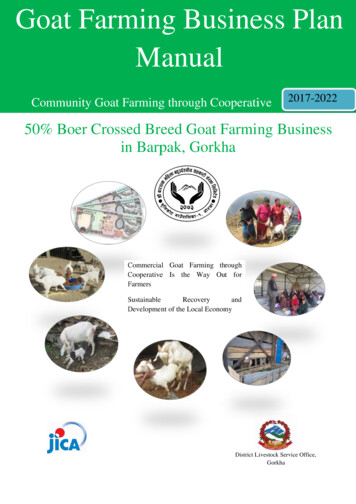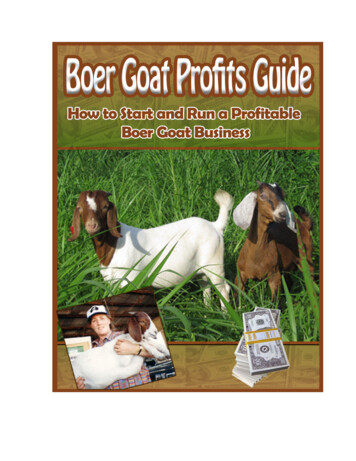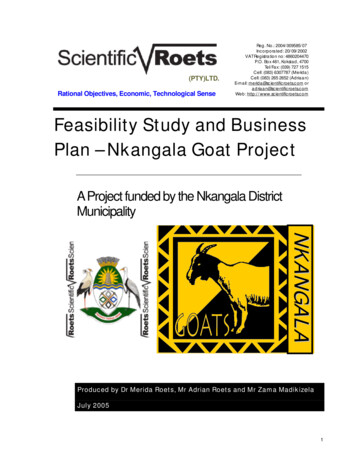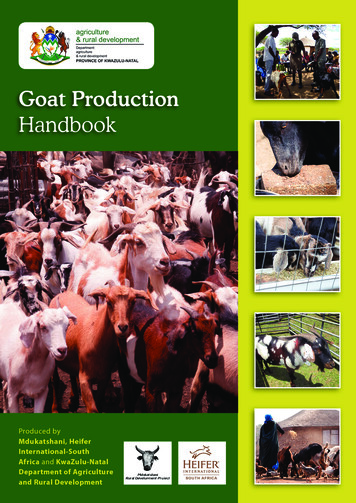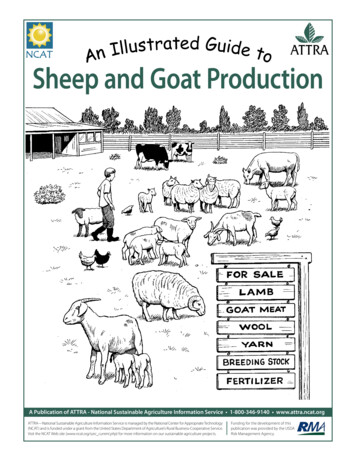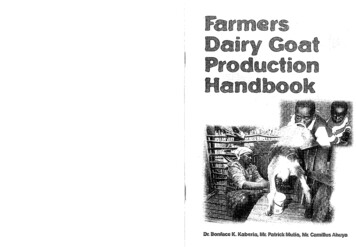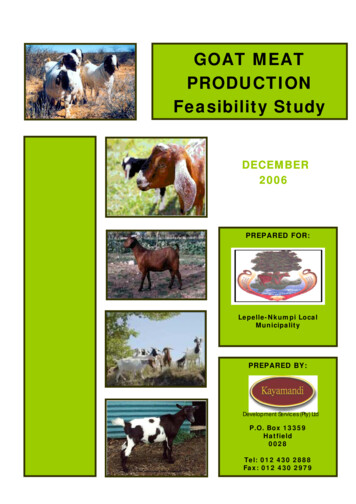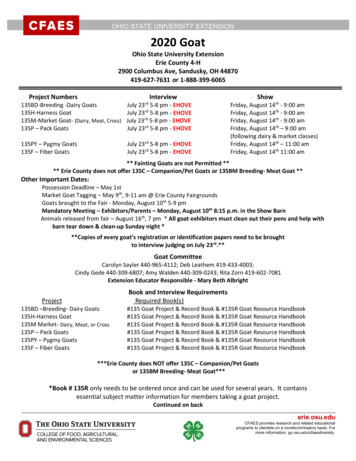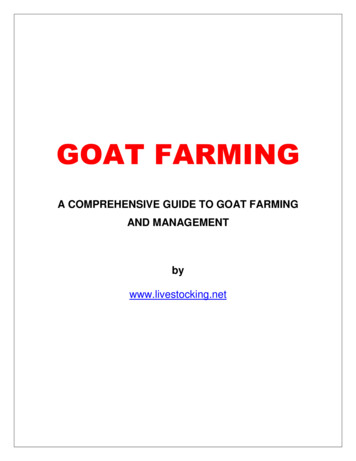
Transcription
GOAT FARMINGA COMPREHENSIVE GUIDE TO GOAT FARMINGAND MANAGEMENTbywww.livestocking.net
Goat Farming Manualwww.livestocking.netTable of ContentsINTRODUCTION TO GOAT FARMING . 521.1Advantages of Keeping Goats . 51.2Disadvantages of Keeping Goats . 61.3Management Systems in Goat Farming. 61.3.1Intensive system or zero grazing . 61.3.2Advantages of intensive system are: . 71.3.3Tethering . 71.3.4Semi-intensive system . 91.3.5Extensive production system . 9HOUSING IN GOAT FARMING . 102.1Why Should You House Your Goat?. 102.2Aspects to Consider for Housing. 122.3How to Build a Goat Shed . 132.4Requirements in the shed. 152.5Housing systems . 152.5.1The elevated ground level shed . 162.5.2The stilted goat shed . 162.63Housing Requirements . 18GOAT FEEDING . . 203.1What do goats need? . 203.1.1Water . 213.1.2Energy . 223.1.3Proteins . 223.1.4Minerals . 233.1.5Other needs . 233.2Intake . 243.3Grasses . 243.3.1Natural grasses . 253.3.2Elephant grass . 252 Page
Goat Farming Manual3.4Crop residues and by-products . 273.5Leguminous forages . 283.6Concentrates. 303.7Practical feeding . 313.7.1Intensive goat keeping . 323.7.2Grazing of larger goat herds . 323.84Final recommendations . 33HEALTH, DISEASES AND PARASITES . 354.1A healthy goat . 364.2Diagnosis of a sick goat . 374.3Infectious diseases . 374.3.1Peste des petits ruminants (PPR; Small ruminants pest). 374.3.2Contagious caprine pleuro-pneumonia (CCPP) . 384.3.3Haemorrhagic septicaemia . 384.3.4Foot-and-mouth disease . 394.3.5Anthrax . 394.3.6Ecthyma or Orf . 404.3.7Brucellosis . 404.3.8Mastitis . 414.3.9Pneumonia . 414.4Diseases due to feeding errors . 424.4.1Bloat . 424.4.2Diarrhoea . 434.5Internal parasites: Worms . 444.5.1Liver fluke (Fascioliasis). 454.5.2Roundworms and tapeworms . 464.5.3Lungworms . 474.65www.livestocking.netExternal parasites . 47REPRODUCTION . . 485.1Heat detection . 483 Page
Goat Farming Manual5.2Breeding . 505.2.1Pure breeding . 515.2.2Cross-breeding . 525.2.3Upgrading . 525.3Reproductive cycle. 525.4Young animals . 545.5Breeds of Goats. 545.5.1Sahelian Goats . 555.5.2Maradi or Red Sokoto . 565.5.3African Dwarf Goats . 565.5.4Saanen . 575.5.5Anglo-Nubian . 585.5.6Toggenburg . 585.5.7Alpine . 595.5.8Jamnapari. 595.5.9Boer goat. 605.66www.livestocking.netDesired characteristics of male goats . 61KID AND YOUNG STOCK REARING . 626.1Kidding . 626.2Kid rearing . 636.3Young stock rearing . 674 Page
Goat Farming Manualwww.livestocking.netCHAPTER ONEINTRODUCTION TO GOAT FARMINGGoats are of high importance because of the many functions they provide. The rearingof goats provides a small but nevertheless significant supply of animal protein in theform of meat and milk. This is particular important for families of low-incomefarmers and the landless that do not have the resources to keep a cow and cannotafford to purchase meat and milk. Access to land for smallholders is becomingincreasingly precarious due to fragmentation, poor implementation of land policies,and irregular sales and allocations.1.1 Advantages of Keeping Goats Goats serve as an inflation proof bank account which can be used when cash isrequired, and the kids are the interest of that account, thus spreading of risks. They know wide climatic adaptation, by browsing not competing for roughagewith other ruminants and making efficient use of fibrous feeds. They can function as the “poor man’s cow” for smallholder families.5 Page
Goat Farming Manual www.livestocking.netGoats have a small size: relatively cheap to purchase, and suitable for homeslaughter, sacrifice and gifts. There are fewer cultural restrictions on ownership and handling of goats bywomen and youth than for cattle or other large livestock. There is a fast reproductive rate: early maturing, short kidding interval, twinscommon, quick returns on investments, quick building up of flock. There are no religious taboos.1.2 Disadvantages of Keeping Goats Goats are inquisitive, need proper fencing and/or stabling or active herding toprevent crop damage. Formal goat market chains are less developed or less accessible than otherlivestock value chains. Small value makes formal credit systems uneconomical or impossible. Goats are susceptible to respiratory diseases and internal parasites.1.3 Management Systems in Goat FarmingDepending on the ecological zone and the production purpose, different farming- andmanagement systems can be distinguished: intensive, tethering, semi-intensive andextensive system.1.3.1Intensive system or zero grazingThis system is more suitable for improved (dairy) goats in the humid and sub-humideco-zones. In the intensive system the goats are confined to a shed and the roughageis provided by a “cut and carry” system. In an intensive management system thesheds are usually separated in a single pen for the buck and possible single pens orgroup pens for the does. Kids are kept in group pens, which are usually separated bysex. In this system controlled mating is practiced. Roughage (grass/fodder crops) canbe cultivated and/or collected from roadsides and fodder- and other trees. Fodder6 Page
Goat Farming Manualwww.livestocking.netbanks of tree legumes can be established and properly handled crop residues can beutilized.1.3.2Advantages of intensive system are: It keeps goats from damaging crops and prevents traffic accidents. Goats can make efficient use of crop residues, kitchen waste/peelings andagricultural by-products. It is well suited to productive animals, exotic breeds and their crosses whichare more susceptible to diseases. It reduces burden of internal and external parasites. It allows for close observation (heat detection, health, feed/water availability).1.3.3TetheringTethering describes a system in which goats are kept in a shed during nighttime,whereas during daytime they are tethered in the vicinity of the house, along theroadside or on public grounds. Tethering of goats is practical only for very smallherds. Only adults are tethered, while young kids are often let loose. Often the sexesare not separated in the shed, so mating is uncontrolled. Feed and water should beprovided in the shed.Two methods are common:i. Tied to a pegGoats, sometimes 1 to 3 together, are tied to a peg by a rope of 3-5 meters length. Byshifting the peg or choosing a different tree or post, the goats are offered a freshgrazing/browsing area (see figure 1).7 Page
Goat Farming Manualwww.livestocking.netFigure 1ii. Tied to a ring on a wire between 2 pegsA rope of about 2-3m long is tied to a ring which slides on a wire about 3-5 meterslong (see figure 2).Figure 2Care has to be taken that the goats do not get entangled or even strangled and thatthe goats will not be attacked by dogs/predators. It is advised to provide a small areawith fresh grazing and/or browsing each time. To prevent trampling of the grass thepegs should be shifted 2 to 3 times per day to offer fresh grazing. The tethering area8 Page
Goat Farming Manualwww.livestocking.netmust offer some shade, especially when the tethering period is prolonged andincludes the hottest part of the day (between 11 am and 4 pm).1.3.4Semi-intensive systemIn the semi-intensive system the confinement of goats is restricted to nighttime andpart of the day. Animals are let out for grazing during a restricted part of the day,usually 3-5 hours supervised by a herdsman. The advantage of this system is that itgives the goats the opportunity to supplement their diet and do some selectivefeeding to overcome dietary deficiencies.During the confinement, stall feeding is practiced. Very often young kids are leftbehind in the shed, corral or yard. Separation of the sexes is rarely practiced,uncontrolled mating is common. An option within this system is grazing the goats infenced paddocks.1.3.5Extensive production systemExtensive goat husbandry systems usually involve larger numbers of animals. Thegoats graze and browse large areas of land that are usually marginal in nature and/orare unsuitable for other agricultural use. The system is more common in the arid andsemi- arid climates. Extensive systems are common for meat and hair goats, but arerarely used for dairy goats, although some goats may be milked temporarily forfamily supply. A very low level of unpaid family labour represents the main input,although for large herds paid labour may be employed. Little management ispracticed except to let them graze in day time and to lock them up for the night innight pens or yards. Breeding is uncontrolled. The goats are watered during the dayat streams, lakes and ponds or water is provided from wells. After the harvest ofcrops the animals can feed on the residues and weeds left in the field. Sometimesmixed herds of sheep and goats graze together. The droppings in the night yards canbe collected as manure.9 Page
Goat Farming Manualwww.livestocking.netCHAPTER 22 HOUSING IN GOAT FARMINGGoats are kept in varying climates. Within each climatic zone many more, smallerzones can be distinguished which can differ greatly. Some are dry others are wet.Sometimes this is combined with heat, or in other places with cold. The conditionscan be stable but are often also extremely variable. In short, each region has its ownrequirements for the housing of animals.2.1 Why Should You House Your Goat?Climate ControlAn important function of housing goats is to protect their health. Just like with manyother (domestic) animals, goats cannot take damp conditions nor draughts well. Withgood housing, a waterproof roof and draught-proof walls to keep out damp anddraughts, you will avoid goats becoming sick. Goats are well protected against thecold by their coat of hair. Extreme heat, on the other hand, bothers them. A goat willsearch for shade by itself if it gets too hot. If no natural shade is available you mustprovide a shelter. Roofing materials like thatch or coconut leaves are preferred asthey absorb the heat from the sun and keep the inside of the shed cooler. Corrugatediron sheets can become very hot from the radiation of the sun, leading to a highertemperature in the shed.Especially pregnant goats, nursing goats and their young are suffering underunfavorable climatic conditions, therefore provide them with protection. Always keepan eye on their breeding, health and feeding as these aspects will be affected whenhousing is not adequate.10 P a g e
Goat Farming Manualwww.livestocking.netObservationGood housing makes it easier to keep an eye on your goats. You can detect and actmore easily when the goats come into heat, during mating, pregnancy and kiddingwhen the goats are kept in a pen than if they wander around freely outside.Disease symptoms such as diarrhoea and coughing can be noticed earlier when thegoats are kept housed or penned. It makes a difference whether you house the goatsindividually or as a group. Within a group an inactive goat, possibly due to a disease,will be noticed sooner. A good shed has a quarantine area where you can separategoats which are probably sick.An advantage of housing is that you can give each animal individual attention andbetter feed. For example, you can control the feeding of pregnant or nursing animalsor a weakened, sick goat. Furthermore, there are certain housing systems, whichmake the milking of goats easier.SafetyPreventing of theft can be another reason for building a shed. It goes almost withoutsaying that the shed must be solidly built and should stand close to the house orcompound. An alert watchdog (and geese) can also help. Furthermore, protectionagainst stray dogs, predators, snakes or vampires may be necessary in certainregions.Especially in densely cultivated areas, a watchful eye must be kept on goats toprevent them from damaging crops. Sometimes this is only necessary for a certainpart of the year, when the crops are in the field.Collection of manureBy keeping goats inside, you can collect their droppings and use these as a fertilizer.Keep collected droppings protected from rain and sunshine when storing as tomaintain the fertilizer value.11 P a g e
Goat Farming Manualwww.livestocking.net2.2 Aspects to Consider for HousingThere is no blueprint for housing, choose for yourself the form which best suits yoursituation. Build the shed in such a way that the goats can easily stay, eat and restthere. Make sure that you can work there with pleasure. Also look for good examplesin the region.Invest in qualityThe investment in good housing may seem high at the time you calculate the cost ofbuilding, but it is low in comparison to the other costs. A good shed will last a longtime and reduce the cost for feed, labour, dead or stolen animals and caring for sickanimals. So do not save on the cost of the building of the shed and good equipmentwithout careful thought.Individual or group housingIn general, goats are housed as a group because this is less labour intensive for thegoat keeper and the building costs of the stable are lower. The goat is a true herdanimal and prefers group housing. In order to avoid unrest the size of the herd mustnot be too large. If the goats do not graze, a surface area of one and a half to twosquare meters of floor space is needed per adult goat. If they do graze one squaremeter per goat is sufficient.Temporary and permanent housingA distinction must be made between temporary and permanent housing of goats. Intemporary housing, the goats are kept penned only at night or during part of the day,the rest of the time they are grazing. If you keep them permanently penned or housed,you must take complete care of the supply of water and feed.Temporary housing has the advantages that the shed can be smaller and that you donot have to provide all the feed and water yourself. This is only possible if there isenough pasture and/or browsing in the area. In densely populated areas with a lot of12 P a g e
Goat Farming Manualwww.livestocking.netcrop production, pasture is often limited and you are usually forced to keep yourgoats permanently housed.In both temporary and permanent housing, the goats are kept within an enclosure.Enclosures can be made of stone piles, stakes, thorns or wire fencing. Planting ahedge of quick-growing shrubs or trees, such as Leucaena, Calliandra or Glyricidia,creates a possibility for fencing. Since goats eagerly eat such bushes, you will initiallyhave to protect the young plants until they are large enough to resist being browsed.Local thorn bushes or cactuses are also suitable for making living hedges. You can puta triangle around the neck of a goat that regularly breaks through the fences.2.3 How to Build a Goat ShedA first decision is where to locate the shed. It must be near the home so that you caneasily keep an eye on the goats.Positioning the shedDepending on the climate, the positioning of the shed can be important. By placingthe length of the shed east - west, you can prevent the sun from heating up the stalltoo much. If, on the other hand, you want the sun to shine on the floor so that thefloor dries up and parasites die, it is better to build the shed along a north-south axis.This is only relevant for ground level sheds, not for stilted sheds with slatted floors.The roof is also very important for good temperature regulation. A wideoverhang/eave prevents too much sun shining on the floor. In cooler climates,sunlight may actually be desirable to warm up the stall. In that case, a large surfacearea of the roof facing south or facing north is useful so that the roof which iswarmed also warms up the shed (see figure 4).VentilationIn warm climates the shed will heat up due to sunshine. Also goats emit heat whendigesting their feed. If the animals cannot get rid of that heat because the surrounding13 P a g e
Goat Farming Manualwww.livestocking.nettemperature is too high, they eat less and therefore produce less. Ventilation is alsoessential to prevent respiratory diseases to which goats are very susceptible. Makethe shed sufficiently high and be sure to there are openings for ventilation in the roofor walls.In warmer climates, where the stalls are fairly open, a low wall (of about 1.20meter)on the side the wind comes from is sufficient. A hedge can also fulfil this function.In wet climates, it is important that the roof is waterproof and has a large enoughoverhang to prevent rain from blowing in. Clues for a suitable way of achieving thiscan be found in the way the roofs of local houses are constructed.The floorThe floor of the stall must be easy to keep clean and should remain dry. A damp anddirty floor stimulates the development of all kinds of germs and worms. The goatsalso get wet and dirty, cool down too much, are susceptible to diseases and producepoorly. If the foundation consists of sand, urine is absorbed well. Daily collection ofthe droppings will keep the floor clean and allows the urine to drain into thesand. A hard clay or loam floor has the advantage that it is easily cleaned. An elevated ground level floor sloping to the sides will prevent rain waterfrom entering the floor and allows urine to drain to the outside. In the wet tropics, an elevated slatted floor using bamboo or wooden slats isadvised.On a solid ground level floor you can put bedding or litter materials in order to keepthe animals clean and to provide good insulation in a cold climate or season. Any typeof dry organic material can be used as bedding; it can be straw, weeds, dry grass orleaves, sawdust, etc. Bedding soaks up urine and droppings, it is advisable to addenough new bedding regularly so that all urine is soaked up and the bedding stays14 P a g e
Goat Farming Manualwww.livestocking.netclean and dry. Be careful that you do not bring in ticks with the bedding materials.The mixture of bedding, urine and droppings piles up and has to be removed aftersome time, e.g. when it is 50 cm high. This mixture makes very good compost whichcan be used on the home garden or field. On the bedding the hooves of the animalsmay grow very rapidly. These must therefore be cut back regularly.2.4 Requirements in the shedIn all housing systems the required roofed space per adult is about 1-1.5m2,depending on the breed. Some separate pens of about 2x2 m are advised for kiddingand sick animals. In order to prevent spreading diseases in case of bacterial or viralinfection to other animals, a separate pen can be considered outside the shed. Inlarger herds it is advised to keep the kids for 1-3 months in the shed when the herd isgrazing. In controlled breeding systems a separate pen is required for the buck.To facilitate easier milking, goats are placed on a platform with a feeding rack in frontso you can constrain the animal and make the animal feel comfortable and at ease.Supply of feed and water in the house is important. Also for systems that rely (partly)on grazing it is advised to supply water, feed and salt/minerals in the shed during thenight. Providing the feed in a rack/manger or in a net hanging from the wall or roofprevents the feed from being trampled upon and becoming dirty and contaminatedwith droppings and urine.Water troughs have to be placed in the shade and be elevated to preventcontamination with droppings and urine.2.5 Housing systemsBasically there are two housing systems, the elevated ground level shedrecommended in the more extensive systems and the stilted goat shed which is mostcommon in the intensive and semi intensive system; however, (“closed”) ground levelsheds are also practiced.15 P a g e
Goat Farming Manual2.5.1www.livestocking.netThe elevated ground level shedIn this system there is a thatch roof for shade in a fenced night yard provided for thegoats. This system is more suitable for arid and semi-arid areas climates where goatsgraze in the day time and is advised for extensive systems with meat production asthe main purpose. It is simple to build and not costly. However, it requires aprotective enclosure. The shed floor is raised with earth about 30 cm above theground level and slightly sloped (see figure 3). In this way water and urine can run offat the same time preventing rainwater to enter the shaded floor, so the floor staysdry. As goats like to play, some rocks or tree trunks can be placed in the yard.Figure 32.5.2The stilted goat shedAs the stilted goats shed requires quite some investment, the system is moreapplicable for intensive milk- and meat production systems and certainly advised forthe humid and semi-humid climates. The slatted floor, with about 1.5 cm spacebetween the slats, is elevated about 70-90 cm above the ground. Goats reach the shedby climbing a wooden ramp.16 P a g e
Goat Farming Manualwww.livestocking.netThe slatted floor is preferably constructed from wood as bamboo may cause woundsto the feet. The shed protects the goats from rain, strong winds and excessivesunshine. Infection stress and problems with internal and external parasites arestrongly reduced and the goats are protected from dogs and wild animals. The shed iseasy to clean and manure can be efficiently collected. The walls should be built withslats with a width of about 5 cm all around. At the lower part of the wall the slatsshould be about 5 to 7.5cm apart, at the higher part of the wall (1m and above)between 20 and 30 cm apart.The walls can be constructed from wood or bamboo. This allows for efficient andsufficient ventilation, essential to prevent respiratory diseases. The eaves of thethatched roof should be long enough to prevent rain from coming in the shed duringstrong and windy rain showers. Division of compartments in the shed is made for themilking goats, the kids and the buck. If possible there should be a separate pen forsick animals away from the main shed.A similar shed can be built on ground level, but the hygiene of the floor has to beconsidered. Daily cleaning or a system of pili
Depending on the ecological zone and the production purpose, different farming- and management systems can be distinguished: intensive, tethering, semi-intensive and extensive system. 1.3.1 Intensive system or zero grazing This system is more suitable for imp
